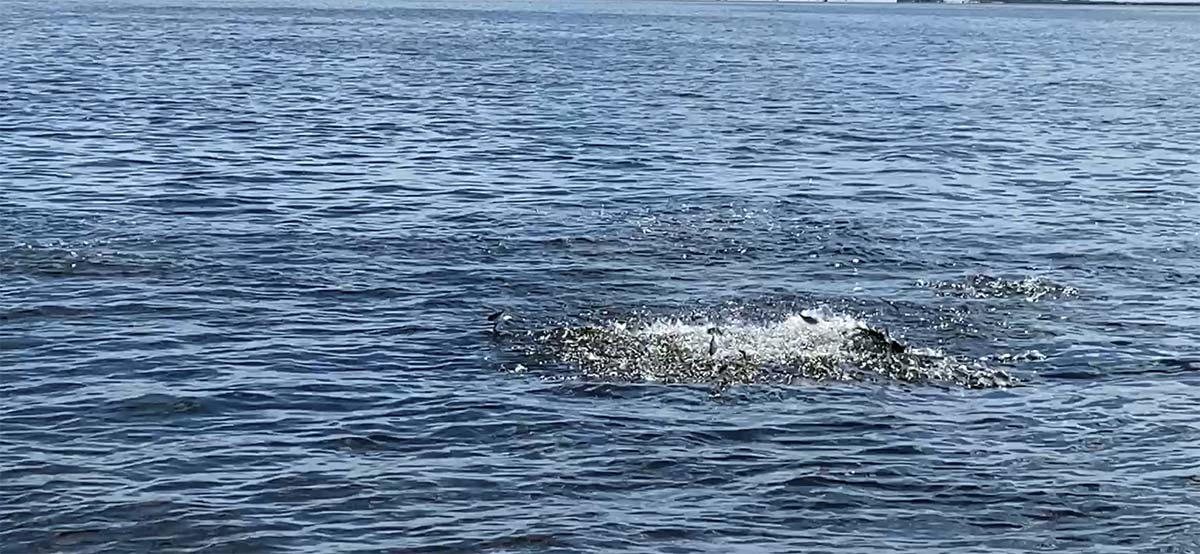
The written set of unwritten rules for chasing a blitz.
What is a blitz? We’ve all heard the term. For those out there who have never seen one, it’s a spectacle in which fish boil through the water, crash on bait, and fly through the air. With fall kicking in, you’ll likely see surface rages of stripers, blues, or even albies. I personally love chasing after blitzes; nothing gets my heart pumping more than looking through the binoculars on my 19-foot whaler when suddenly a metric ton of splashes erupts on the surface. While I’ve certainly blown many shots at blitzing fish, over time I’ve learned to prepare for the moment. Here’s a few tips to help you catch more blitzing fish on your boat.
The first thing to consider when fishing a blitz is how to approach the fish; every pod of surface fish is different. Although there are times in which I can simply drive up to a school of fish, a majority of the time it’s not so easy. The first thing I always consider when approaching a blitz is distance, specifically how close I can get to the fish. While my engine is quiet, it’s certainly not immune to spooking a pod of happy fish. A good rule of thumb I follow when pulling up to the school is to start roughly three quarters of a maximum cast away. That said, it’s crucial to consider wind direction when judging the distance. If the cast is out of range. I simply slide the boat into forward in order to get into the ideal range. Although it can be tempting to get closer, maintaining distance will prevent spooking the fish and ensure that you get more shots over time.
The second factor to consider when chasing a blitz is the angle of your approach. In the past, I’ve been guilty of approaching nose first; this leads to over adjustment when fish start changing directions. I’ve learned that the best way to approach the school of fish is to set up so that my bow and stern are parallel to the fish. Because I fish with friends quite often, it allows both people on the bow and stern to get the perfect cast.
The next thing to remember is tackle preparation; when the blitz occurs, the last thing you want to do is tie on a fresh leader or re rig your rod. I can’t count the amount of times in which I’ve blown my chance because I was re-rigging while fish showed up within easy casting range. In order to up my chances of capitalizing on my shot, I always carry an extra rod in a spare rod holder that I dedicate to blitzing fish. Another aspect of preparation is organization. If you’re not using a rod or plug, keep them stowed away in a safe area. By having the proper storage systems in place, you’ll spend more time casting at blitzes and less time untangling gear. If I know I’m chasing blitzes on my boat, I always try to keep the amount of equipment on deck to a minimum, with all of the terminal tackle and plugs in one easily accessible location.
The final and most important aspect of chasing a blitz is to understand your surroundings. Chances are, if you spot a blitz, other fishermen also see the fish. In order to remain courteous to others, it’s best to consider a few rules. First, never drive through the school of fish. This goes without saying, but it puts the fish down and ruins the fun for everyone. Second, don’t cut someone off. If someone is ahead of you and is clearly setting up on the fish, don’t speed ahead and cut them off. Let them make their cast, drift by the school, and when an opening presents itself, feel free to slide in at an appropriate distance. Third, respect space. If someone’s fighting a fish, allow them to do so. The last thing you want is another angler’s line in your prop. Fourth, and the most important rule of them all, is maintain a safe speed. It’s easy to get on plane and slam the boat in forward. In the interest of your safety and others, approach the fish at an appropriate speed.
Fishing to blitzing fish is an absolute blast; it’s what we as fishermen often live for. By approaching the fish with a mindset that considers distance, angle of approach, preparation, and the interests of other anglers, you’ll have a better shot at landing more fish in a blitz.




